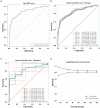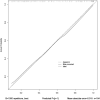Nomogram to predict ventilator-associated pneumonia in large vessel occlusion stroke after endovascular treatment: a retrospective study
- PMID: 38803642
- PMCID: PMC11129686
- DOI: 10.3389/fneur.2024.1351458
Nomogram to predict ventilator-associated pneumonia in large vessel occlusion stroke after endovascular treatment: a retrospective study
Abstract
Background: Ventilator-Associated Pneumonia (VAP) severely impacts stroke patients' prognosis after endovascular treatment. Hence, this study created a nomogram to predict the occurrence of VAP after endovascular treatment.
Methods: The individuals with acute ischemic stroke and large vessel occlusion (AIS-LVO) who received mechanical ventilation and endovascular therapy between July 2020 and August 2023 were included in this retrospective study. The predictive model and nomogram were generated by performing feature selection optimization using the LASSO regression model and multifactor logistic regression analysis and assessed the evaluation, verification and clinical application.
Results: A total of 184 individuals (average age 61.85 ± 13.25 years, 73.37% male) were enrolled, and the rate of VAP occurrence was found to be 57.07%. Factors such as the Glasgow Coma Scale (GCS) score, duration of stay in the Intensive Care Unit (ICU), dysphagia, Fazekas scale 2 and admission diastolic blood pressure were found to be associated with the occurrence of VAP in the nomogram that demonstrating a strong discriminatory power with AUC of 0.862 (95% CI, 0.810-0.914), and a favorable clinical net benefit.
Conclusion: This nomogram, comprising GCS score, ICU duration, dysphagia, Fazekas scale 2 and admission diastolic blood pressure, can aid clinicians in predicting the identification of high-risk patients for VAP following endovascular treatment in large vessel occlusion stroke.
Keywords: acute ischemic stroke with large vessel occlusion; endovascular treatment; mechanical ventilation; nomogram; ventilator-associated pneumonia.
Copyright © 2024 Zhu, Liang, Zhu, He, Zou, Yang, Li, Liao, Deng, Liang, Zhao, Zhao, Chen, He and Ning.
Conflict of interest statement
The authors declare that the research was conducted in the absence of any commercial or financial relationships that could be construed as a potential conflict of interest.
Figures







Similar articles
-
Severe Cerebral Small Vessel Disease Burden Is Associated With Poor Outcomes After Endovascular Thrombectomy in Acute Ischemic Stroke With Large Vessel Occlusion.Cureus. 2021 Feb 4;13(2):e13122. doi: 10.7759/cureus.13122. Cureus. 2021. PMID: 33728139 Free PMC article.
-
Development and validation of a prognostic nomogram based on objective nutritional indexes in ischemic stroke patients with large vessel occlusion undergoing endovascular thrombectomy.Nutr Metab Cardiovasc Dis. 2022 Aug;32(8):1903-1912. doi: 10.1016/j.numecd.2022.03.029. Epub 2022 Apr 14. Nutr Metab Cardiovasc Dis. 2022. PMID: 35606225
-
Is ventilator-associated pneumonia in trauma patients an epiphenomenon or a cause of death?Surg Infect (Larchmt). 2004 Fall;5(3):237-42. doi: 10.1089/sur.2004.5.237. Surg Infect (Larchmt). 2004. PMID: 15684794
-
Prediction of long-term mortality in patients with ischemic stroke based on clinical characteristics on the first day of ICU admission: An easy-to-use nomogram.Front Neurol. 2023 Apr 14;14:1148185. doi: 10.3389/fneur.2023.1148185. eCollection 2023. Front Neurol. 2023. PMID: 37122313 Free PMC article.
-
[Timing of sequential noninvasive mechanical ventilation following early extubation in aged patients with severe community-acquired pneumonia].Zhonghua Wei Zhong Bing Ji Jiu Yi Xue. 2020 Mar;32(3):324-329. doi: 10.3760/cma.j.cn121430-20191224-00072. Zhonghua Wei Zhong Bing Ji Jiu Yi Xue. 2020. PMID: 32385997 Chinese.
References
LinkOut - more resources
Full Text Sources

